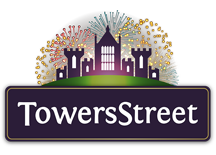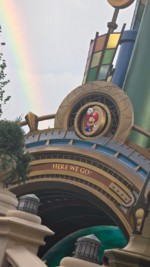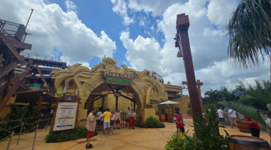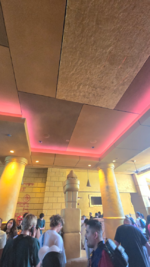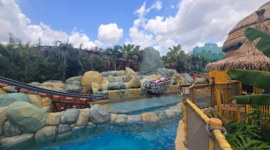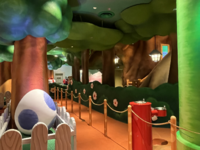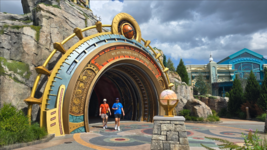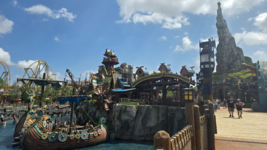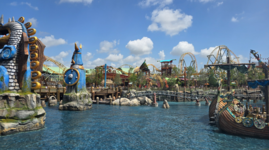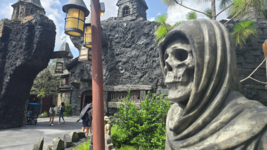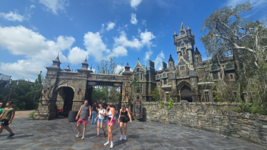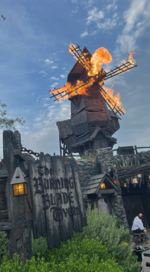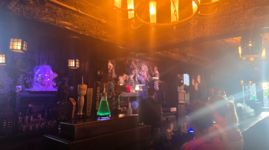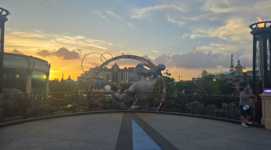Danny
TS Contributor
- Favourite Ride
- Steel Vengeance
[[INTRO & BAR HELIOS]]
I’d barely got into the meat of writing up my trip report from the Middle East (it WILL be finished and posted, I promise) before I was booked onto a very last-minute trip to Miami via Orlando.
Freshly opened and already supposedly rewriting the rulebook, there was simply no world in which I wasn’t going to shoehorn Epic Universe in.
At any cost.
With single-day tickets almost mythical in their scarcity, I opted for the two-day park-to-park ticket. Day one would be fully dedicated to Epic. Day two split between IOA and Studios, a nostalgic reset and a contrast to the gleaming newcomer, drawing crowds to the theme park capital of the world.
To set the tone, I spent the evening before at the Helios Grand Hotel, a jewel in the park’s resort offering and an architectural centrepiece. Even if you’re not staying there, it’s well worth a visit, particularly Bar Helios with its 360-degree panorama over Orlando and, more importantly, Epic Universe itself.
The bar is stunning. Elegant. Polished and modern, with a vaulted dome ceiling that showcases the constellations, reportedly accurate according to a quietly excited astronomer a few stools down. Its views are framed perfectly for golden hour. Getting a reservation here is no easy feat, and bar seating fills rapidly. But if you can get in early and secure a perch, it’s well worth lingering. Watching the new park shift from daylight to dusk is something of a visual masterclass with an elegant, slow-burn reveal of the lighting design, from hidden uplights to glowing spires and ride silhouettes emerging against the skyline.
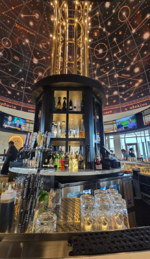
The outdoor terrace should be the perfect place to eat. But unless you’re comfortable with guests leaning over your table for photos during the evening Celestial Fountain Show, it’s better saved for drinks only. That said, the transformation of the park during that final hour of daylight is spellbinding and this terrace is one of the finest vantage points from which to soak it all in.
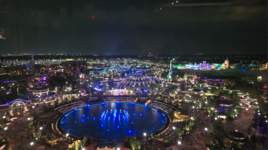
Back on the ground floor, the observation deck out back offers a more tranquil but equally powerful perspective. The statue of Helios, perfectly aligned with Luna on the opposite end of the park, forms a deliberate and photogenic axis that becomes a must-capture moment for many. Once the crowds have filtered out post-show, the podium becomes a quiet and pleasant space lit with twilight hues, and the orchestral score gently weaves through the breeze. It’s theme park prelude as poetry.
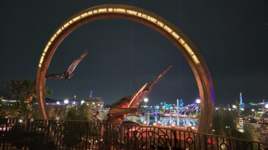
[[PART 1 - ENTRY & WIZARDING WORLD OF HARRY POTTER - MINISTRY OF MAGIC]]
The next morning began with the now-familiar shuffle from the car park towards the grand entrance. A long queue in the baking muggy Floridian heat (one unfortunate lady collapsed at the security checkpoint, which put a temporary halt to batching proceedings), but one that otherwise quickly dispersed once the gates officially opened. The Chronosphere sits point and centre and anchors this new entry plaza. It’s a stunning new icon on the Orlando skyline and inevitably a magnet for smartphones, but that popularity becomes its own challenge. Getting a clean shot without guests walking through it is difficult, and if you’re not up for weaving through patches of photographers and dawdlers, it’s a small navigation headache.
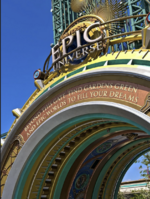
Once through, the crowd splits cleanly and strategically to either side of Celestial Park.
Off to the right, the torrent of Potter fans surges toward Battle at the Ministryy, with a few branching off into Berk or, for the coaster geeks, a straight-line sprint to Stardust Racers. To the left, Nintendo fans dash for Mario Kart and Donkey Kong, while horror lovers beeline for Darkmoor in search of their monstrous fix.
We chose to fall in with the Ministry crowd, mostly for the sake of efficiency. The ride doesn’t open until 10am, but by joining the early surge, We could knock it out before the wait time spiralled north of 200 minutes, which it inevitably does. The surrounding Parisian Wizarding World feels immediately familiar in its design DNA; a spiritual cousin to Diagon Alley, with towering facades, tight urban canyons, and impeccable sightline control. It’s immersive, enclosed, and dense with detail. The wand interactivity here has been levelled up again, with more spell points than in Hogsmeade or Diagon Alley combined, tucked cleverly into every crevice and corner.
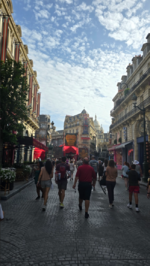
However, at this time of day, the charm is momentarily sacrificed to crowd control. Extended queue lines take over the streets, guiding guests into the Ministry queue. And the queue itself? It’s long. VERY long. The initial walk-through offers little in the way of spectacle. You bypass the signature Floo Network fireplace entry element and end up in a plain, extended outdoor queue that seems to stretch on for eternity. Our own experience was unfortunately undercut when the floo network portals failed to emit smoke, robbing the scene of its magical flourish.
But all is forgiven the moment you step into the Ministry Atrium. This is one of those rare theme park moments that seems impossible. The scale, accuracy, and sheer presence of the room are astonishing, an uncanny recreation that immerses you instantly. The grand hall is accessible even to non-riders; you can walk in through the fireplaces (which were working later in the day) and marvel without needing to queue.
The ride’s full queue is designed for huge capacities, but it refuses to feel barren. Themed office corridors, Ministry departments, and magical touches abound. Worth noting: the Single Rider Queue skips many of these scenic pre-show rooms, so if you’re here with a serious Potterhead on for the lore, you’ll want to commit to the main queue.
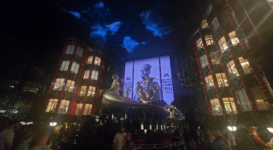
As for the ride itself: it’s undeniably impressive. The animatronics are some of the most advanced Universal has produced, and the movement is fluid and lifelike. There’s one particular scene towards the end with Umbridge transitioning from physical set piece to media, with the ride’s conclusion scene at the trial showcasing the highest quality of Universal animatronic detailing yet. But it’s also the most screen-reliant of the Wizarding World’s three headliners. It leans heavily into high-tech motion simulation, and although it’s a polished package, it doesn’t stack up with the immediate “wow” factor of Forbidden Journey or even Gringotts. I wouldn’t call it a disappointment, far from it, but for those expecting a more tangible dark ride experience, this one leans firmly into cinematic action. I did feel a little shortchanged on the physical side of the sets, but mercifully, Epic Universe has a far better ride suited to that in a neighbouring area (more to come on that later).
Still, taken as a whole, from queue to exit, Battle at the Ministry is an anchor attraction with extraordinary production value. It may not reinvent dark rides or storytelling in the same way Universal has done previously, but it delivers an immersive spectacle that cements the ambition and direction taken with the Parisian Wizarding World.
Having disembarked Battle at the Ministry just 45 minutes after its official 10:00am opening, we wanted to take the opportunity to grab breathing room and find our bearings. With the big early-morning queue now ticked off, we resisted the temptation to dash to the next major headline immediately and instead allowed ourselves a slower pace. And there’s no better place to do that than Celestial Park.
[PART 2] CELESTIAL PARK
Unlike its siblings at IOA and Studios (parks that throw you straight into narrative lands or immediate sensory assault) Epic Universe begins at a gentler tempo. Celestial Park is the central hub, but it’s not the usual traffic junction of people and purpose. It’s elegant. Calming.
It leans brilliantly into stylised design rather than the hyper-themed lands surrounding it, and that’s its strength. Shimmering fountains choreographed to subtle music, wide open walking paths that chew through crowds, impeccable landscaping, and water features all contribute to an environment that feels curated for moments to relax, unwind and reflect. For a park otherwise built around towering IPs, this is a chance for the original vision of the park to shine. You’re encouraged to do nothing for a moment, and it’s surprisingly effective.
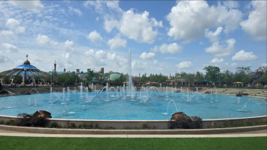
We grabbed a beer from one of the small kiosks overlooking the fountain. No queue. No rush. We simply sat. Watching families, solo travellers and overprepared vloggers circle the central hub while the gentle melodies of Celestial Park’s score floated overhead? Pure bliss.
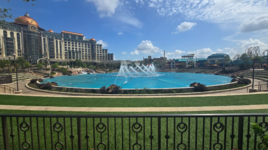
Of course, Celestial Park does include its own two attractions. Constellation Carousel is grand but not overdone. It’s presented as a high capacity, multi-generational headline entrance ride that adds a quaint twinkle to the area. Notably, multiple of the various gondolas on the ride were out of action, which does deter the visual aspect somewhat with the multiple ‘Out of Order’ signage speckled throughout the ride platform.
Celestial Park’s crown jewel, of course, is Stardust Racers. It’s Mack’s unapologetically spectacular gift to America.
You approach through a vast plaza dominated by the ride’s opening set-piece: the dual 180° turns and launch tracks that stretch boldly into the imposing station building. It’s theatrical in its own right, feeling like a kinetic sculpture that never stops moving. The structure itself, a kind of miniature echo of Chimelong Paradise’s colossal park shed, is scaled to fit Epic Universe’s tighter theming without losing any grandeur. Inside, it leans into its namesake, equal parts Victorian train station and celestial observatory, complete with vaulted beams and industrial-flair details that would feel right at home in a Jules Verne fever dream.
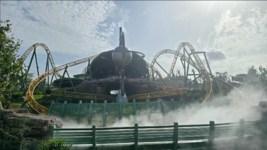
The queue, though elegantly styled, does start to feel like a slog; not quite a cattle pen, but close. It wraps around the rear of the coaster’s layout in a long oval formation, snaking back and forth without a huge amount of variety. There’s no big story moment to break it up, no sudden reveal or indoor scene, just steady progress in a covered canopy under the open sky. That said, it gives you clear sightlines of the layout. each passing train adding a spike of anticipation, and the progression is at least measurable if you keep count of the oval segments.
Eventually, you’re routed back to the station’s central hub, where lockers and security scans come next. This is where you choose your layout: yellow or green. We opted for yellow first (saving the green for a nighttime duel), and made our way upstairs to the loading platform.
Even here, another 10–15 minutes of platform queuing awaits as the ride hosts bustle with admirable efficiency. It’s evident the system could run smoother if they added the extra two trains (there were four running when we visited, and I believe the system is built to accommodate six), but it’s hard to be anything but impressed by the operation.
And the trains themselves? Stunning. Possibly the most beautifully designed Mack trains to date, a glowing blend of steampunk elegance and sleek modern flair. The nod to Back to the Future with the rear-mounted flux capacitors as they flicker away is a delight. The restraints are generous but comfortable, and with the blessing of a knowing ride host pal, I was granted just the right amount of looseness for what was about to come.
Let’s get one thing out of the way. Mack’s launches have never been their strong point. Compared to the raw punch of an Intamin, they often feel like polite suggestions rather than actual propulsion. But Stardust throws that legacy into orbit.
The initial launch begins predictably, with a solid but unspectacular rolling start. Then, just as your brain registers the “typical Mack” sensation, the train kicks. It steps up a gear mid-track with a surprising punch that’s both unexpected and genuinely thrilling. A Mack launch that takes you by surprise? Yes, really.
What follows is a symphony. The duelling aspect is executed to perfection, with head-on crossovers, mirrored dives, and the now-iconic Celestial Spin. a moment of such visual and physical genius that it feels like the ride is folding space itself. Trains pass within what feels like inches, twisting and tumbling in a synchronised pirouette across the sky. It’s as beautiful to observe as it is to ride.
And then there’s the airtime. Glorious, ridiculous, ejector airtime. You know it looks good in the aerial shots, what you don’t expect is just how aggressive it feels when paired with those open restraints. You lift hard. Over and over. At times, it genuinely feels like the ride is trying to launch you into the tourist helicopters buzzing over I-Drive.
There’s a second launch, too, almost forgotten until you hit it. It keeps the pace relentlessly high, never coasting to the finish line. And throughout it all, there’s a consistency that elevates Stardust Racers above most of its siblings: no matter the time of day, where you sit, or which side you ride, it delivers. It doesn’t sag. It doesn’t rattle. It just flows, fast, fluid, and joyful.
Is it a top ten? For me, yes, but it was close. Given the extreme similarities overall, I paired them as one for the ranking positioning. They only just dislodged Voltron from my personal list. Despite Europa Park’s homegrown offering with more immersive theming, sharper transitions, and greater variety of elements overall, Stardust remains a triumph in its own right.
It’s not the most intense, nor the most immersive. But what it is is one of the most consistently enjoyable pairs of coasters I’ve ever ridden. With its soaring onboard soundtrack, visually stunning layout, head-to-head train choreography and absolutely wild airtime moments, Stardust Racers is an ecstatic ride. A love letter to coaster enthusiasts that doesn’t forget to be fun for everyone else, too.
And at night? With the onboard lighting glittering against the sky and the duelling trains glowing like twin comets? It’s magic. Pure, joyful, diabolically clever magic. I had high expectations for Stardust Racers, and they delivered.
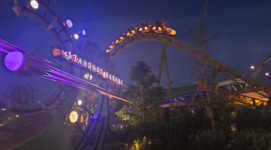
Last edited:
